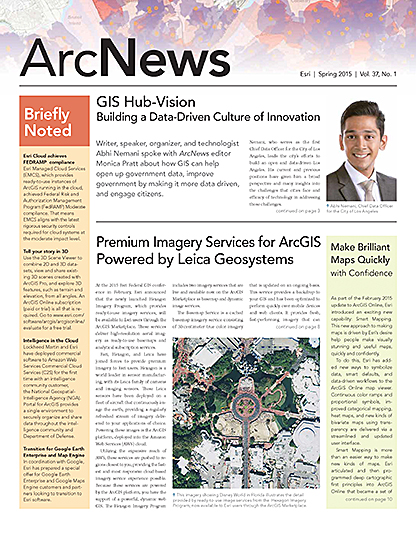Building a Data-Driven Culture of Innovation

Writer, speaker, organizer, and technologist Abhi Nemani spoke with ArcNews editor Monica Pratt about how GIS can help open up government data, improve government by making it more data driven, and engage citizens.
Nemani, who serves as the first Chief Data Officer for the City of Los Angeles, leads the city’s efforts to build an open and data-driven Los Angeles. His current and previous positions have given him a broad perspective and many insights into the challenges that cities face and efficacy of technology in addressing those challenges.
Before joining the city, he helped build, launch, and run Code for America, a nonprofit technology organization dedicated to reinventing government for the 21st century. Previously, Nemani worked for Google developing social engagement strategies. He also worked at the Rose Institute, where he managed multiple local government transparency research teams and at the Center for American Progress, where he focused on connecting a national network of public-minded advocates.
He graduated magna cum laude from Claremont McKenna College with an honors degree in philosophy, politics, and economics. He also studied political philosophy and rhetoric at the University of Oxford.
Nemani is a member of the board of directors for the OpenGov Foundation, a member of the board of advisers of Significance Labs, and has served as Innovator-in-Residence at GovDelivery. He was one of the featured speakers at the 2015 CIO Summit held March 25–26 at Esri’s Redlands, California, headquarters.
Q: What is the role of GIS in opening up data and making government more efficient and open?
Place matters. Particularly for local governments. Key services ranging from policing and fire prevention to building inspections and infrastructure repair all center around a place—a location, geography. GIS serves as a local government’s guide to navigate and understand a place, and what’s happening there. Accordingly, massive amounts of data are attached to a place, and that data is critical both to agencies aiming to find efficiencies and innovations and citizens hoping to understand the work of their government. Already, we are seeing governments and citizens use GIS data to improve the quality of life by doing things like reducing blight, tracking and responding to citizen requests, and boosting new business development.
Q: What unique opportunities do big cities offer for applying technology and exploiting data to deliver better government?
Commonly, it’s seen that the opportunity in big cities is their scale and size. I would argue their diversity is more interesting. So many different cultures, places of origin, and ways of life. Nowhere is this more true than Los Angeles, a city so very rich in its diversity. This means that as we consider the use of technology and data, profound and deep empathy is hard but essential, which I suspect will make the tools we create that much more meaningful.
Q: Are the models for applying technology in small and large jurisdictions different?
There’s no question that between large and small jurisdictions the capacity for technology development varies. Yet now, the emergence of reusable tools and software as a service levels the playing field. Now what’s built in a big city could be used in a small one. A start-up built anywhere could be used by a big or a small city. What’s important for this new model to work, however, is the cultivation of a vibrant civic technology ecosystem any city can participate in.
Q: Government is being described as a platform these days. Is GIS a vital part of that platform?
The notion of government as a platform fundamentally means that innovation can come from anywhere—inside government or out. That’s because the data that had typically been locked within Capitol walls is now openly available for anyone to use, remix, and build upon. This only works if citizens are interested and willing to step up and get involved. And they are, particularly when there is an opportunity related to a place where they live and care about. That’s why opening geospatial data is so attractive for those wishing to make government more of a platform. People care about the buildings near them, the schools their kids are eligible for, or the new businesses on their block. More than that, they care about how all of those sum to a picture of the health and well-being of their community. GIS helps paint that picture.
Q: You’ve written about the need to integrate public data more deeply into citizens’ lives? What do you mean?
I firmly believe the best way to connect with someone is to go to where they are. Thus, I also believe the next step for open data is to go more proactively to where citizens are. That means not just posting the restaurant inspection scores on an open data portal, but integrating those scores with restaurant search engines such as YELP. It means publishing building inspection records on Zillow. It means incorporating traffic and transit information on Google, Waze, and Apple. All these things are, in fact, already happening. Indeed, I think it’s just the start. What’s next is exciting: what are the other consumer apps that could be made more civic?
Q: How can existing GIS implementations in a city support working with startups to solve problems unique to urban areas?
An often overlooked potential consumer of open government data is the start-up community. As we have seen with start-ups such as OpenCounter, BlightStatus, and others, geospatial information is critical to their success. GIS leaders in a city would do well to proactively reach out to the entrepreneurs in the city to see whether they might be able to help make the notion of their government as a platform more real.
Q: You and others have said that a key strategy for improving government technology and its ability to solve big problems with limited resources is following Apple’s example of building an ecosystem of apps. How do GIS and mapping fit into this ecosystem?
Platforms like the Apple iOS and Android systems work because there are common devices, software, and systems for them to run on. An iOS developer can build in one language for one device and know it can scale to hundreds of millions of users. In the public sector, this kind of confidence is often lacking, given the texture of the legacy IT landscape, jurisdiction to jurisdiction. GIS systems, however, cut across jurisdictional lines with common tools, schemas, and software, providing a platform for scalable innovation.
Q: Your vision for better government technology emphasizes not just coming up with workable solutions but also creating agile and elegant software that benefits not only the public but public servants. Could you talk about why this is important and how this relates to GIS?
Not only should we be creating beautiful and elegant citizen-facing solutions but also developing better tools for public servants to better serve the public: data analysis tools to prioritize service delivery, workflow systems to streamline communications, or data collection tools to speed up on-the-ground reporting, just to name a few. These are force multipliers. They enable public servants to serve more people better, faster, and smarter.
Q: What will it take to move government in this direction?
Governments already are moving in this direction. Here in the City of Los Angeles just recently the Department of Sanitation, for example, just deployed a GIS-based mapping and routing platform, replacing their previous paper-based system; both the police department and fire department use geo-based platforms for their real-time, responsive management systems; and others use GIS to plan out how effective, equitable, and useful new initiatives will be. What’s needed is to take examples such as these, and others, to build the momentum for a more data-driven culture of innovation in every city.

